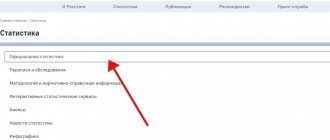Home / Alimony / Services and services - how to find out alimony arrears?
In Russia, every third alimony payer is in arrears. These are official statistics; according to unofficial statistics, the figure is higher. Bailiffs impose certain sanctions that encourage the payment of this debt. They restrict certain rights of unscrupulous payers (driving vehicles, traveling abroad, seizing property and accounts). This can be prevented if you find out the debt in a timely manner and pay it off.
Where is information about debtors and amounts contained?
There are several important points to consider before contacting the authorities, which contain information about debtors and amounts. All restrictions are introduced based on:
- Court decisions;
- Decrees of the bailiff, which carries out measures to implement the judicial act.
This means that if a claim was not filed, the case was not considered by representatives of Themis and they did not make a decision, no one can impose any restrictions. Employees of the Federal Bailiff Service (FSSP) act on the basis of the issued act. They do not have to go to court to restrict the debtor’s rights; they do this on their own, issuing appropriate decisions.
Each procedural action that is carried out against persons within the framework of enforcement proceedings is recorded in the FSSP database.
Based on this, you can find out the alimony debt both on the basis of a court decision and through information received from the FSSP . These are the two main primary sources containing data on debt. Moreover, the bailiffs have the most accurate information about what debt and imposed restrictions exist at the time of the appeal. They record not only the total amount, but also the amount of funds paid or collected as part of enforcement proceedings.
If you are interested in the issue related to the search for alimony, we recommend that you familiarize yourself with this material.
Interim conclusion: you can find out the alimony debt if it is collected officially, there has been an appeal to the court and a corresponding decision, and enforcement proceedings have been opened. If the payer does not fulfill obligations for the financial support of children, ex-wife, parents, but the recipients of the money do not initiate enforcement proceedings, applying for information to the FSSP or the court will give the answer that there is no information in the database. Such persons are left to independently calculate the resulting debt, based on the title documents (agreement or judicial act), the presence or absence of payments on them.
The procedure for indexing alimony debt
Indexation is a recalculation of the monthly alimony amount collected, which is carried out periodically in order to protect the alimony recipient from the negative effects of inflation. Its necessity is due to the fact that alimony is a long-term payment and, therefore, is subject to depreciation. Indexation can only be applied to the following types of alimony payments:
- Payments assigned in the form of a fixed amount.
- Payments assigned as a share of the child's subsistence level in a constituent entity of Russia or multiples of the same subsistence level. If a child's subsistence minimum has not been established in a region of Russia, the child's subsistence minimum fixed at the federal level is applied (in 2021 it is equal to 10,181 rubles).
The Family Code establishes that only 2 categories of persons have the right to carry out indexation:
- The head or accounting department of a legal entity or an individual entrepreneur who employs the alimony worker.
- A bailiff in charge of enforcement proceedings against the alimony payer.
To calculate the amount of indexed alimony yourself or to check the correctness of the bailiff’s calculations, you must use the following formula: NPM/SPM x AL = ALI.
Explanation of formula names:
- NPM – new living wage, in rubles.
- SPM – old cost of living, in rubles.
- AL – alimony before indexation, in rubles.
- ALI – indexed alimony, in rubles.
Let us illustrate the calculation procedure with an example. Let’s say that in 2021 the cost of living per child was 9,000 rubles, and in 2021 it was increased to 10,000 rubles. The amount of monthly alimony paid before indexation was 5,000 rubles in 2021. It follows that after indexation, the alimony payer will have to pay 10,000 / 9,000 x 5,000 = 5,555.55 rubles every month.
The increase in alimony payments and the recalculation are approved:
- By order of the bailiff.
- By order of the management of a legal entity or individual entrepreneur.
At the same time, we must not forget that alimony requested over the past 3-year period must also be indexed. If the bailiff forgot to do this, it is necessary to file a complaint with the head of the bailiff service or his deputy and demand that alimony be recalculated taking into account indexation.
Face-to-face ways to check if there are debts by name
The need for the payer to check the debt independently is explained by the fact that he can find out about the fact that restrictions are being applied to him at the very last moment. For example, at the airport when traveling to a resort or while traveling by personal vehicle from one city to another. Another case is seized bank accounts and the inability to withdraw money from them.
According to the law, the bailiff imposes restrictions by decree. He sends a copy of it to the debtor, thereby notifying him of the measures being taken against him. Even if the payer does not sign for this notice or does not find it in the mailbox, this will not in any way affect the introduction of restrictions against him.
Therefore, you should take the initiative yourself and contact the relevant institutions to find out your debts, namely :
- In the FSSP;
- To the multifunctional center.
In the first case, you should find out the position, surname, name and patronymic of the bailiff who is conducting enforcement proceedings against the debtor. You should contact the territorial body of the FSSP. First you need to find out the opening hours, whether there are office hours, and a contact phone number on the official website.
When visiting a bailiff in person, you must have your passport with you. Another identification document (identity card, driver's license) will also work. Having specified the name, the FSSP employee will find the case, indicate the stage of enforcement proceedings, the measures taken and the restrictions imposed. In addition, he will report the actions that are expected from the debtor in order to terminate enforcement proceedings and remove any restrictions from him.
Not only the payer, but also the recipient and their authorized representatives can contact the FSSP. The latter must submit a notarized power of attorney. The bailiff has the right to refuse permission for other persons who are not parties to the process.
When visiting the multifunctional center, you must have your passport with you. In this case, assistance is provided by an employee of the institution, who will use the database to determine all the above information and report it.
How to find information about your debts?
Searching the blacklist of debtors on the bailiffs website by last name, number of the court decision, enforcement proceedings is the best way. To do this, go to the FSSP portal. On the main page you will see a search bar that will allow you to find out information about enforcement proceedings. Indicate your full name or case number; at the end of the set of numbers the abbreviation IP is indicated. After that, within a few seconds, you will see a table that will present the latest information.
This is what a valid enforcement proceedings number should look like
Here you will see information about the production number, court decision, amount of debt, and contact details of your bailiff.

by full name and date of birth of the debtor

By enforcement proceedings number

By number and type of executive document
Algorithm via the Internet (free)
It is not necessary to visit government agencies in person. You can find out your alimony debt without leaving your home. You need a computer or laptop, another device for accessing the Internet (tablet, smartphone), as well as access to the network. Data can be obtained through the following resources :
- State Internet portal of court decisions;
- Official website of the FSSP;
- Unified portal of public services;
- Private commercial online databases;
- Social media.
The most reliable information is located in government databases and can be obtained free of charge. Commercial resources have a more convenient interface, but they are not responsible for the accuracy of the data and may be incomplete. Some resources, such as the FSSP website, do not require registration; you just need to enter the debtor’s last name. Others, for example, the Unified Portal of Public Services, require registration on the site, only after which the user gets access to information about the debt balance.
To avoid misunderstandings, it is recommended to clarify the data obtained online with the territorial divisions of the FSSP. This can be done by sending a written request or by contacting the bailiff in person.
These resources can help you learn the following:
- Amount of alimony debt.
- Information about the proceedings: the FSSP case number, from what date it is being conducted, the name of the employee who is directly involved in it.
Data on the amount of debt allows you to plan a budget, make a decision on challenging it in court, restructuring, etc. The case number is required to submit written requests, complaints, and statements. This speeds up the verification of the request, preparation and sending of a response to it. Finally, having found out the bailiff’s details, you can contact him, clarify the information, and make an appointment.
Website of the Bailiff Service (FSSP)
The easiest and fastest way to find out alimony arrears within the framework of enforcement proceedings (IP) is through the FSSP website. As stated above, no registration is required. The algorithm of actions is as follows:
- Go to the bailiffs resource.
- Click on the “Services” button.
- Select the “Individual Entrepreneur Data Bank” section, and in it – search for individuals.
A window will open for the user, in which you need to enter the territorial body of the FSSP, which maintains the individual entrepreneur, as well as the debtor’s data. The service prompts you to enter your last name, first name and patronymic, date of birth, but you can limit yourself to just your last name. After this, the “find” button is pressed and the code value is entered and displayed on the screen.
After a few seconds, information appears on the service’s website about the availability of individual entrepreneurs regarding citizens with the specified surname, namely:
- Case number.
- Details of the writ of execution on the basis of which the individual entrepreneur is carried out.
- The amount of debt, other information about it.
- Contact details of the bailiff who is involved in this case.
Other data, for example, restrictions imposed against the debtor, should be obtained additionally from other databases. The FSSP website does not issue them. Therefore, when planning a vacation, debtors need to check with the border service whether there is a ban on leaving the country. If you have a vehicle, you should clarify the prohibition on registration actions with it, other restrictions should be found on the online resources of the traffic police.
It is recommended that owners of vehicles who bought them second-hand also take an interest in such information. Restrictions may also be imposed on sellers' debts.
To find out more complete information about the debt and the sanctions imposed against the payer, you need to check the data on another resource. You can pay off your debt on the FSSP website. The money is received by the service and then transferred to the recipient.
We look at the Public Services Portal
The government services portal provides extensive information, but you must first register on it. The created account will help in the future when applying for other government services, it simplifies the exchange, registration, issuance of documents, and obtaining the necessary information.
When registering, in addition to passport data, you must indicate SNILS, passport number and series, who issued it and when. The verification of the entered information is carried out within 1-2 days, after its completion a notification is sent to the user’s website.
Further algorithm of actions:
- Log in to the site using your account.
- Go to the service catalog, select authorities, and in them the FSSP.
- A query for open enforcement proceedings is entered into the search bar. Data is provided instantly.
In the information received, you can find and view information not only about the amount of debt, the FSSP employee who is handling the case, but also about the restrictions imposed. The data is saved to a computer or printed on paper.
Online applications and other methods
Specialized websites and groups on social networks provide scripts that can be used to find out alimony arrears by last name. As stated above, it is less accurate than on the official FSSP resource, but in general it can be used to track the situation in the dispute between the recipient and the payer. In addition, there are mobile applications, by downloading which both parties can be promptly notified about the status of a specific debt, including alimony.
These resources are taken from the database of enforcement proceedings , which is located on the official website of the FSSP. Therefore, you can only find out the case number, bailiff details and the amount of debt. It is recommended to check the rest of the information with a FSSP employee or monitor the online resources of other government services. For example, information about the introduction of restrictions for debts may be posted on the website of the Federal Migration Service, but it should be clarified.
You may find the following information interesting: rules for recalculating alimony.
In addition, no one is responsible for information posted in commercial free databases on websites and social networks. Accordingly, there is no one to file a claim with.
Where and how can I find out the amount of alimony debt?
You have the following ways to view this information:
Articles on the topic (click to view)
- Assignment of the right to claim under alimony obligations is possible
- Formula for calculating penalties and fines for alimony: sample
- What are the consequences of non-payment of alimony in 2021?
- Reducing alimony debt over the past period
- Payment of alimony voluntarily without agreement
- Criminal liability for non-payment of alimony under Art. 157 of the Criminal Code of the Russian Federation
- Is alimony from financial assistance withheld for vacation?
- Through the Internet:
- in the database of enforcement proceedings posted on the website of the Federal Bailiff Service;
- on the Unified Portal of State and Municipal Services;
- through a special social networking application.
- Through the bailiff department at your place of residence:
- upon direct contact;
- in writing/by mail;
- by phone.









